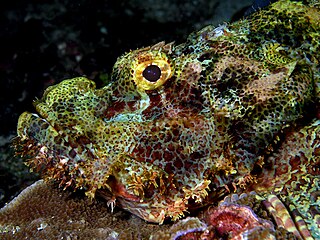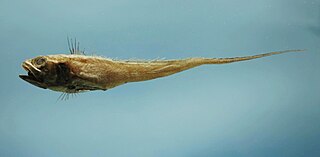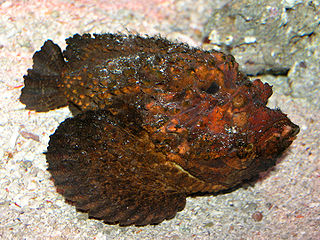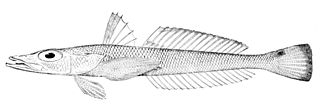
The Scorpaenidae are a family of mostly marine fish that includes many of the world's most venomous species. As their name suggests, scorpionfish have a type of "sting" in the form of sharp spines coated with venomous mucus. The family is a large one, with hundreds of members. They are widespread in tropical and temperate seas, but mostly found in the Indo-Pacific. They should not be confused with the cabezones, of the genus Scorpaenichthys, which belong to a separate, though related, family, Cottidae.

Grenadiers or rattails are generally large, brown to black gadiform marine fish of the subfamily Macrourinae, the largest subfamily of the family Macrouridae. Found at great depths from the Arctic to Antarctic, members of this subfamily are amongst the most abundant of the deep-sea fish.

Macroudidae is a family of deep sea fish, a diverse and ecologically important group, which are part of the order of cod-like fish, the Gadiformes. The species in the Macrouridae are characterised by their large heads which normally have a single barbel on the chin, projecting snouts, and slender bodies that taper to whip-like tails, without an obvious caudal fin but what there is of the caudal fin is often confluent with the posterior dorsal and anal fins. There are normally two dorsal fins, the anterior dorsal fin is quite high, the posterior quite low but is longer and takes up a greater proportion of the fish's of the back, species in the subfamily Macrouroidinae have a single dorsal fin. The long anal fin is almost as long as the second dorsal fin is nearly as long as the posterior dorsal, and sometimes it is longer. The pelvic fin is inserted in the vicinity of the thorax and normally has 5-17 fin rays but are absent in Macrouroides. The body is covered in small scales and if they have a photophore, it is usually on the midline of the abdomen just in front of the anus. The bioluminescence of these fish is produced by symbiotic bioluminescent bacteria. The structure of the skull has been used to show their placing in the Gadiformes, but they differ from the typical cods in that they possess one stout spine in the anterior dorsal fin.

Tilefishes are mostly small perciform marine fish comprising the family Malacanthidae. They are usually found in sandy areas, especially near coral reefs.

Synanceiinae is a subfamily of venomous ray-finned fishes, waspfishes, which is classified as part of the family Scorpaenidae, the scorpionfishes and their relatives. These fishes are found in the Indo-Pacific oceans. They are primarily marine, though some species are known to live in fresh or brackish waters. The various species of this family are known informally as stonefish, stinger, stingfish and ghouls. Its species are known to have the most potent neurotoxins of all the fish venoms, secreted from glands at the base of their needle-like dorsal fin spines. The vernacular name, stonefish, for some of these fishes derives from their behaviour of camouflaging as rocks. The type species of the family is the estuarine stonefish.

Cardinalfishes are a family, Apogonidae, of ray-finned fishes found in the Atlantic, Indian, and Pacific Oceans; they are chiefly marine, but some species are found in brackish water and a few are found in fresh water. A handful of species are kept in the aquarium and are popular as small, peaceful, and colourful fish. The family includes about 370 species.

The dottybacks are a family, Pseudochromidae, of fishes which were formerly classified in the order Perciformes, but this has been revised and the family is regarded as of uncertain affinities, or incertae sedis within the Ovalentaria, a clade within the Percomorpha. Around 152 species belong to this family.

The Percophidae, duckbills, are a family of percomorph fishes, from the order Trachiniformes, found in tropical and subtropical waters of the Atlantic and Indian Oceans and in the southwestern and southeastern Pacific.

Gymnapogon is a genus of fish in the family Apogonidae. They are native to the Indo-West Pacific and central Pacific Oceans, where they occur in reefs and nearby habitat types. These species are usually no more than 5 centimeters long and have semitransparent bodies without scales. The genus name is a compound noun formed by combining the Greek gymnos meaning "naked", referring to the lack of scales in the type species, Gymnapogon japonicus, and Apogon, the type genus of the Apogonidae. One species, the B-spot cardinalfish, is notable for its larvae being rather large, conspicuous and fast-swimming.
Paxton concilians, also known as the Paxton's cardinalfish, is a species of cardinalfish native to the Indian Ocean waters off of western Australia where it is found over the continental shelf at depths of from 46 to 80 metres. This species grows to a length of 7.6 centimetres (3.0 in) SL. This species was previously classified as the only known member of its genus and of its subfamily but the 5th edition of Fishes of the World placed the genus in the subfamily Pseudaminae. The genus name honours the Australian zoologist John R. Paxton of the Australian Museum in Sydney who provided the describers with the type specimens while the specific name means the uniting of disparate parts into a whole, a reference to this species continuous dorsal fin.

Trimma nasa, commonly called the nasal dwarfgoby or nasal pygmy goby, is a species of goby from the Western Pacific. They are small fish, averaging at around 2 cm (0.79 in) in length. They are bright orange and transparent yellow in life, with a white stripe running down from between the eyes to the upper lip and a dark brown spot at the base of the tail fin. They are usually found in large schools in the sloping or vertical drop-offs at coral reef edges.

The Apogoninae are the most species-rich and, of its shape, size, color and habitat, most diverse subfamily of cardinalfishes (Apogonidae). It can be found in coastal tropical and subtropical regions of the Indian Ocean, the eastern Pacific and the Atlantic, down to depths of 300 meters.

The Kurtiformes consist of two extant families of ray-finned fish, the Indo-Pacific Kurtidae and the much more diverse and widespread Apogonidae. The order is part of the Percomorpha clade and is regarded by many authorities as a sister taxon to the Gobiiformes.

Oxudercidae is a family of gobies which consists of four subfamilies which were formerly classified under the family Gobiidae. The family is sometimes called the Gobionellidae, but Oxudercidae has priority. The species in this family have a cosmopolitan distribution in temperate and tropical areas and are found in marine and freshwater environments, typically in inshore, euryhaline areas with silt and sand substrates.

Plesiopinae is one of two subfamilies in the family Plesiopidae, the longfins or roundheads.

Pomacentrinae is one of four subfamilies in the family Pomacentridae which includes the clownfishes and the damselfishes. It is the most diverse of the subfamilies in the Pomacentridae with around 21 genera and approximately 200 species.

Congrogadinae is a subfamily of ray-finned fishes, one of four subfamilies that make up the family Pseudochromidae, these elongated fish are commonly called eel-blennies.

Pseudochrominae is a subfamily of ray-finned fishes, one of four subfamilies that make up the family Pseudochromidae, the species within the subfamily are commonly called dottybacks. They are small reef-associated marine fish which have an Indo-Pacific distribution.
Pseudoplesiopinae is a subfamily of the family Pseudochromidae, the dottybacks, it consists of small species of coral-reef inhabiting fish which are distributed throughout the Indo-Pacific.

Astrapogon stellatus is a species of ray-finned fish in the family Apogonidae, the cardinal fishes. It lives in the tropical western Atlantic Ocean, the Caribbean Sea and the Gulf of Mexico. It is commonly known as the conchfish because it typically conceals itself in the mantle cavity of a living queen conch by day.


















